Chapter: Civil : Engineering Geology : Structural Geology And Geophysical Method
Classification Of Folds
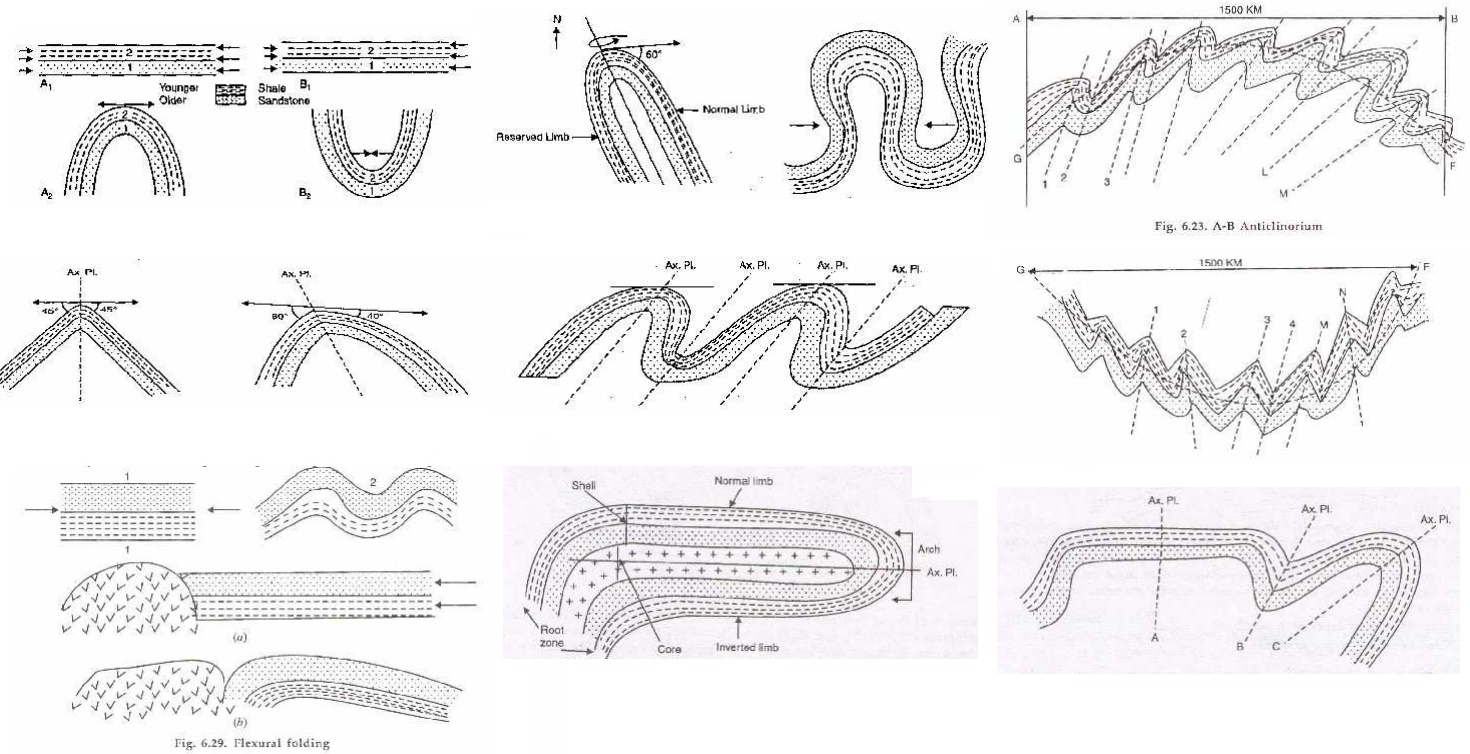
Classification Of Folds
Anticlines are
defined as tho se folds in which
the
strata are uparch ed, that is, these become CONVEX UPWARDS ;
![]()
the geologically olde r rocks occupy a position in
the interior of the fold, oldest being positioned at th e core of the fold and
the youngest forming the outermost flank,
![]()
the limbs dip away from each other at the crest in
the simplest cases.
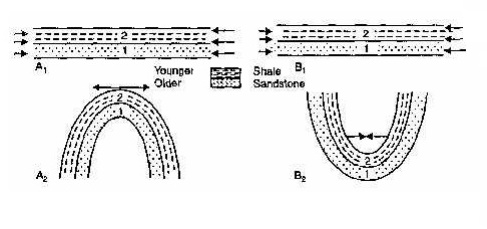
Synclines
the
strata are downar ched, that is, these become CONVEX DOWNWARDS;
![]()
the geologically younger rocks occupy a position
in the core of th e fold and the older rocks form the outer flanks, provided
the normal order of superposition is not d isturbed,
![]() in the simplest cases in
synclines, the limbs dip towards a common c enter.
in the simplest cases in
synclines, the limbs dip towards a common c enter.
![]()
Position of Axial Plane
Depending upon the nature a nd
direction of the stresses the axial plane in a r esulting fold may acquire any
position in space, that is, it may be vertical, inclined or eve n horizontal.
Following main types are re cognized on the basis of position of the axial
plane in the resulting fold:
Symmetrical Folds
Ø These are
also called normal or upright folds. In such a fold, the axia l plane is
essentially vertical.
Ø The limbs
are equal i n length and dip equally in opposite directions.
it may be an anticline or syncline and when
classified, may be described as symmetrical anticline / syncline as the case
may be.
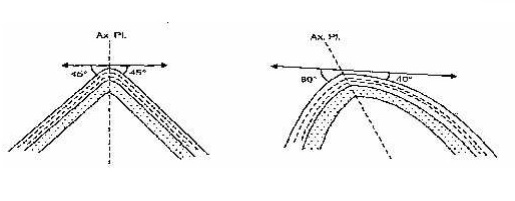
Asymmetrical Folds
All those folds, anticlines or synclines, in which
the limbs are unequ al in length and these dip uneq ually on ether side from
the hinge line are termed as asymmetrical folds.
Overturned
folds
Ø These are
folds with inclined axial planes in which both the limbs are dipping
essentially in the same general direction.
Ø The
amount of dip of the two limbs may or may not be the same.
Ø Overfolding
indicates very severe degree of folding.
Ø One of
the two limbs (the reversed limb) comes to occupy the present position after
having suffered a rotation through more than 90 degrees.
The other limb is known as the normal limb.
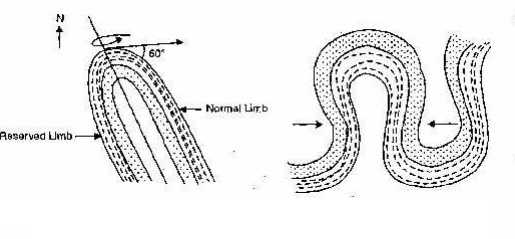
Ø In certain cases, both the
limbs of a fold may get overturned because of very high lateral compression.
Ø It may be
originally either an anticline or a syncline but the extreme compression from
opposite sides results in bringing the limbs so close to each other that the
usual dip conditions may get reversed -anticlinal
limbs dip towards each other and the synclinal limbs dip away from each other.
Ø Such a
type of fold is commonly referred to as a fan fold
Ø In such
folds, the anticlinal tops are said to have opened up into a broad, fan-shaped
outline due to intense compression in the lower region.
Isoclinal
Folds
Ø These are
group of folds in which all the axial planes are essentially parallel, meaning.
that all the component limbs are dipping at equal amounts.
Ø They may
be made up of series of anticlines and synclines
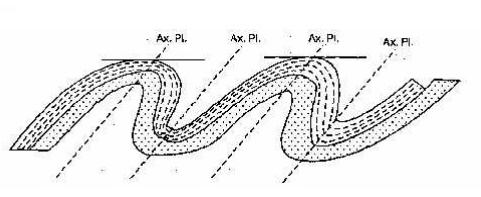
Recumbent Folds
Ø These may
be described as extreme types of overturned folds in which the axial plane
acquires an almost horizontal attitude.
Ø In such
folds, one limb comes to lie exactly under the other limb so that a drill hole
dug at the surface in the upper limb passes through the lower limb also.
Ø The lower
limb is often called the inverted limb or the reversed limb.
Ø Other parts
of a recumbent fold are sometimes named as follows:
the arch, which
is zone of curvature corresponding to crest and trough in the upright folds;
the shell, which is the outer zone made up
mostly of sedimentary formations;
the core, which
is the innermost part of the fold and maybe made mostly of crystalline igneous
or metamorphic rocks;
the root or the root zone, which
is the basal part of the fold and may or may not be easily traceable;
once traced it can throw light whether the fold was originally an anticline or
syncline that has suffered further inversion.
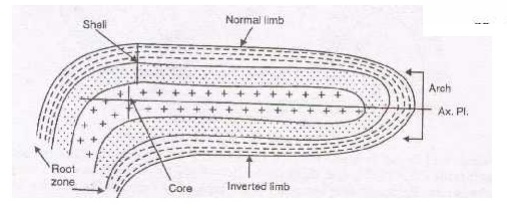
Conjugate Folds
In certain cases a pair of folds that are apparently related
to each other may have mutually inclined axial planes.
Such
folds are described as conjugate folds.
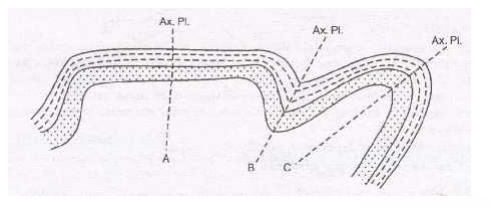
The individual folds themselves may be anticlinal
or synchnal or their modifications.
Box Fold
It may be described as a special type of fold with
exceptionally flattened top and steeply inclined limbs almost forming three
sides of a rectangle.
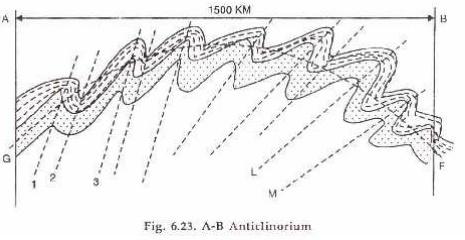
Ø In both
the anticlinorium and synclinorium, presence of large number of secondary
folds, faults and fracture systems is a characteristic feature.
Ø Similar
folding but signifying still larger bending and uplifting of strata on
sub-continental scales is expressed by the terms GEANTICLINES AND GEOSYNCLINES
respectively.
Ø Great
importance is attached to the major depressions, the geosynclines, in the
process of mountain building discussed elsewhere.
Ø The
geosynclines are believed to serve as depositional fields or basins of
sedimentation to which sediments derived by the erosion of the adjoining
gentilities get accumulated and compacted.
Ø This material is then compressed and uplifted in the second stage of orogeny, to gradually take the shape of mountain systems.
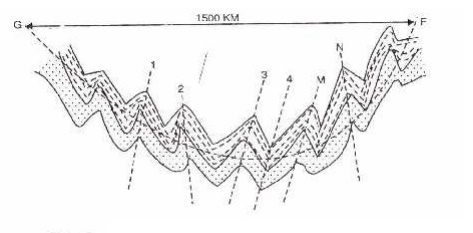
Related Topics